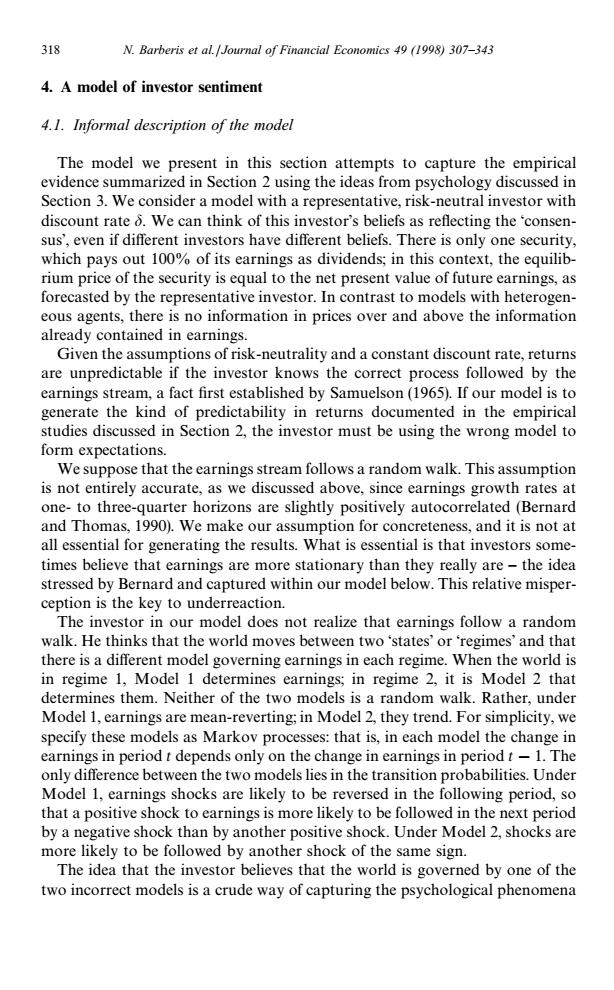正在加载图片...

318 N.Barberis et al./Journal of Financial Economics 49 (1998)307-343 4.A model of investor sentiment 4.1.Informal description of the model The model we present in this section attempts to capture the empirical evidence summarized in Section 2 using the ideas from psychology discussed in Section 3.We consider a model with a representative,risk-neutral investor with discount rate 8.We can think of this investor's beliefs as reflecting the 'consen- sus',even if different investors have different beliefs.There is only one security, which pays out 100%of its earnings as dividends;in this context,the equilib- rium price of the security is equal to the net present value of future earnings,as forecasted by the representative investor.In contrast to models with heterogen- eous agents,there is no information in prices over and above the information already contained in earnings. Given the assumptions of risk-neutrality and a constant discount rate,returns are unpredictable if the investor knows the correct process followed by the earnings stream,a fact first established by Samuelson(1965).If our model is to generate the kind of predictability in returns documented in the empirical studies discussed in Section 2,the investor must be using the wrong model to form expectations. We suppose that the earnings stream follows a random walk.This assumption is not entirely accurate,as we discussed above,since earnings growth rates at one-to three-quarter horizons are slightly positively autocorrelated(Bernard and Thomas,1990).We make our assumption for concreteness,and it is not at all essential for generating the results.What is essential is that investors some- times believe that earnings are more stationary than they really are-the idea stressed by Bernard and captured within our model below.This relative misper- ception is the key to underreaction. The investor in our model does not realize that earnings follow a random walk.He thinks that the world moves between two 'states'or 'regimes'and that there is a different model governing earnings in each regime.When the world is in regime 1,Model 1 determines earnings;in regime 2,it is Model 2 that determines them.Neither of the two models is a random walk.Rather,under Model 1,earnings are mean-reverting;in Model 2,they trend.For simplicity,we specify these models as Markov processes:that is,in each model the change in earnings in period t depends only on the change in earnings in period t-1.The only difference between the two models lies in the transition probabilities.Under Model 1,earnings shocks are likely to be reversed in the following period,so that a positive shock to earnings is more likely to be followed in the next period by a negative shock than by another positive shock.Under Model 2,shocks are more likely to be followed by another shock of the same sign. The idea that the investor believes that the world is governed by one of the two incorrect models is a crude way of capturing the psychological phenomena4. A model of investor sentiment 4.1. Informal description of the model The model we present in this section attempts to capture the empirical evidence summarized in Section 2 using the ideas from psychology discussed in Section 3. We consider a model with a representative, risk-neutral investor with discount rate d. We can think of this investor’s beliefs as reflecting the ‘consensus’, even if different investors have different beliefs. There is only one security, which pays out 100% of its earnings as dividends; in this context, the equilibrium price of the security is equal to the net present value of future earnings, as forecasted by the representative investor. In contrast to models with heterogeneous agents, there is no information in prices over and above the information already contained in earnings. Given the assumptions of risk-neutrality and a constant discount rate, returns are unpredictable if the investor knows the correct process followed by the earnings stream, a fact first established by Samuelson (1965). If our model is to generate the kind of predictability in returns documented in the empirical studies discussed in Section 2, the investor must be using the wrong model to form expectations. We suppose that the earnings stream follows a random walk. This assumption is not entirely accurate, as we discussed above, since earnings growth rates at one- to three-quarter horizons are slightly positively autocorrelated (Bernard and Thomas, 1990). We make our assumption for concreteness, and it is not at all essential for generating the results. What is essential is that investors sometimes believe that earnings are more stationary than they really are — the idea stressed by Bernard and captured within our model below. This relative misperception is the key to underreaction. The investor in our model does not realize that earnings follow a random walk. He thinks that the world moves between two ‘states’ or ‘regimes’ and that there is a different model governing earnings in each regime. When the world is in regime 1, Model 1 determines earnings; in regime 2, it is Model 2 that determines them. Neither of the two models is a random walk. Rather, under Model 1, earnings are mean-reverting; in Model 2, they trend. For simplicity, we specify these models as Markov processes: that is, in each model the change in earnings in period t depends only on the change in earnings in period t!1. The only difference between the two models lies in the transition probabilities. Under Model 1, earnings shocks are likely to be reversed in the following period, so that a positive shock to earnings is more likely to be followed in the next period by a negative shock than by another positive shock. Under Model 2, shocks are more likely to be followed by another shock of the same sign. The idea that the investor believes that the world is governed by one of the two incorrect models is a crude way of capturing the psychological phenomena 318 N. Barberis et al./Journal of Financial Economics 49 (1998) 307—343